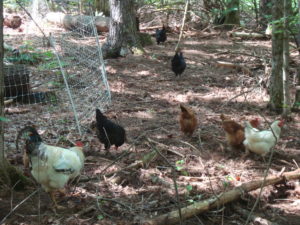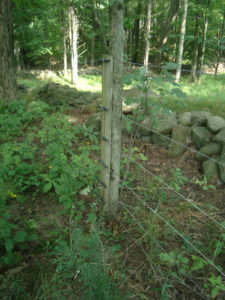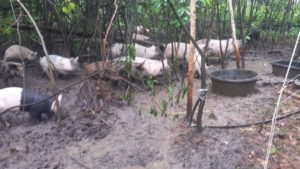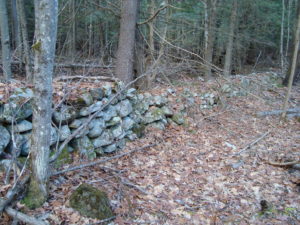Assessing Woodlands for Silvopasture
Silvopasture is a land-management system that simultaneously focuses on the sustainable and integrated production of trees, forage and livestock.
By Brett Chedzoy and Peter Smallidge
There are examples in New York and the Northeast for the use of almost all types of livestock including poultry, small ruminants such as sheep or goats, and larger ruminants such as cattle. Past generations of farmers, woodland owners and foresters had concerns about using woodlands for grazing. As described below, those previous concerns can be circumvented, and silvopasture can be a positive tool for forest health, soil health and carbon sequestration.

Chickens and turkey are viable livestock for a silvopasture. Portable electric net keeps the birds in and the four-legged predators out. Birds of prey can cause problems for poultry.
Image provided.
Each type of livestock would have specific needs for use in a silvopasture system. Poultry, for example, would be rotationally grazed differently than sheep or cattle because they are more likely to feed on seeds and insects than on forages in a silvopasture understory. They can be integrated with ruminants or grazed alone. Their action in scratching the soil surface as they look for insects creates a suitable seedbed to establish forages that need exposed mineral soil (Figure 1). The particular challenge with poultry is to ensure their safety from predators, especially birds of prey.
As with any new enterprise or effort, planning must include deliberate attention to the opportunities and challenges that exist. Because silvopasture integrates multiple production systems, the assessment is more comprehensive than for simpler systems. There are several silvopasture resources on the ForestConnect publications page. Notably there is a guide for developing a silvopasture and also links to case study examples of silvopasture in the Northeast.
On this webpage, there is also a site assessment guide. The site assessment guide considers factors that influence the suitability of an area, and offers suggestions on how to remediate factors that are less than ideal. The assessment would apply individually and collectively to management units (i.e., stands) to be included in the silvopasture. The site assessment guide has additional details and provides a scoring system, and a discussion of each factor follows.
- Site quality for an area is based on the ability of the site to grow trees and forages. This factor addresses primarily soil characteristics related to drainage and fertility. Historically the earliest lands to be abandoned from agriculture were those least fertile, least accessible to the farmer, wetter or drier than other areas, and/or less easily tilled (Figure 2). The site quality of forest land will usually be less optimal than lands currently in single commodity agricultural production. For silvopasture the drainage and fertility are of greatest interest. Except perhaps for some orchards, existing lands with trees are not likely able to be tilled. Soil treatments would be implemented through livestock or surface applications of seed or other amendments.
Silvopasture is possible, and optimized with a system of permanent perimeter fences (shown) that are segmented with portable electric net (Figure 1) or fence. These systems allow for the necessary frequent movement of livestock among paddocks to prevent damage to soils and root systems.
Image provided. - Silvopasture involves rotational grazing of livestock within fences. The areas to be included will ideally have good access regardless of season or recent weather patterns. The owner will need to inspect fences, facilitate the movement of livestock from other paddocks, and potentially access the site for vegetation treatments. Because most woodland will need some thinning to reduce the abundance of low-value trees to stimulate the establishment and growth of forages, harvesting may provide the opportunity to improve access. In other circumstances, some investment in woods-roads or access trails may be required.
- Livestock with a small body size (e.g., chickens, turkey, sheep, goats) are less likely than large body size livestock to alter soils saturated by a significant rainfall. The goal is to minimize “pugging” or “post-holing” wet soils, which can alter soil structure (Figure 3). Some amount of pugging can be reversed with winter freeze-thaw cycles. Soils that are prone to saturation can be avoided during wet conditions. Installing drainage tile in silvopasture is not common, but this activity is sometimes practiced in some poorly drained sugarbushes of Quebec and might have application in a silvopasture. Related to this consideration of drainage and erosion is the presence of vernal pools or wetlands from which ruminant livestock should be excluded.
- Livestock usually learn how to avoid situations that can cause them harm, but not always. The owner needs to look for hazards such as gullies, flood-prone streams, or areas of high predator density. Sheep and goats may lean against small trees in open brushy pastures to access foliage and have a leg caught in a fork. In areas adjacent to public roads, poor fencing and high traffic should be viewed as a hazard. Remediation of these concerns is often best addressed through heightened attention to effective fencing, or removal of the hazard if feasible.
- The potential for silvopasture has expanded only because of the availability of portable and low cost fencing, usually within a permanent perimeter fence (Figure 4). The terrain of the silvopasture is best when access for installation and inspection is simple. Areas with heavy understory vegetation will require more effort prior to installing fencing. Nothing fosters frustration quite like loose livestock, so paddocks need regular inspection to repair damaged fences. Gentle slopes and open understories facilitate inspective and access via foot or farm vehicles.
-
This is an example of allocating space in a woodlot to livestock, but would not qualify as silvopasture. Unless expertly managed pigs can cause great damage to woods, and pigs in a seasonally flooded woods without forage will cause harm to soils and desired species.
Image provided.Livestock can obtain a portion of their water from vegetation, but some supplemental supply of water is needed. The best circumstances allow for potable water with minimal investments of infrastructure. Sometimes, water is hauled to the location, wells can be drilled or dug and enhanced with the addition of distribution systems, or surface water improvements are installed. Every paddock need not have water as livestock can have access to adjacent recently grazed paddocks that have a water source.
- The size, shape and location of the management unit under consideration influence the logistics of utilization. The size should be big enough to justify the fixed-cost effort (e.g., water supply), noting that variable costs (e.g., thinning effort per acre) may also be a factor. The shape influences the ease and efficiency of fencing. An isolated area is less optimal than an area that is proximate to existing grazing operations. Perhaps it goes without saying that among isolated sites, a large area is preferred to a small area.
- The evaluation of each site, assuming there is some investment needed to create or use it, should always be within the context of all other sites on the property. Consideration of alternate sites aligns with the strategy to focus on those sites with the best utility. Note, however, that a site may be suboptimal when considered alone, but might serve an important role over the course of a grazing season For example, the suboptimal site might have a location (e.g., bridging two other areas) or other factors (e.g., good soil for use during the rainy season) that increase its relative worth.
Stone walls are proof of past utilization for agriculture. These soils may not be as productive as current open farm land, but they have some inherent productive capacity. Other forest lands may also be productive, but weren’t located to allow for past agricultural production.
Image provided. - A silvopasture, by definition, has trees. These are often timber species in natural stands or plantations, but trees could also be present as a fruit or nut orchard. Trees provide benefits to livestock, especially in the way they can buffer hot summer sun and cold winter winds. Trees reduce the energy needs of the livestock to thermoregulate. The “ideal” condition of trees as forest, orchard or open pasture may depend on the needs of the owner, or the owner’s ability to make the best of a given situation. In some cases a fully stocked forest stand provides the opportunity to thin the woods and obtain firewood and low-value sawlogs, but with some significant effort and time. Alternatively a pasture allows for planting of trees and creating spatial patterns or species (e.g., conifer as a living barn) that may facilitate some other aspect of the property. The least desirable example of this attribute might be a severely high-graded stand or an area dominated by invasive trees species such as European buckthorn (Figure 5). While even these less desirable examples help the animals thermoregulate, they offer little future value to the owner.
- The plants found in the forest understory of a developed silvopasture are often different from the plant species found in open pastures because of the contrasting amounts of sunlight. However, livestock in the silvopasture need forages of high nutritional quality. The ideal woodland has existing understory plants to browse, or the ability to establish those through canopy thinning and scarification of the litter layer. Many woodland have seed beds of stored agricultural plants, but the owner may also decide to sow seed to accelerate forage establishment or to influence the composition of forages available (Figure 6).
For owners interested in additional revenue, especially those with existing livestock operations that would like an expanded land base, silvopasture is worth considering. Modern technologies of portable electric fence and rotational grazing allow owners to avoid the concerns of “putting cows in the woods.” More information and a network of silvopasture graziers is available at http://silvopasture.ning.com.
This article originally appeared on www.ForestConnect.com, a program project of Cornell University Cooperative Extension and the NYS Department of Natural Resources. Support for ForestConnect is provided by the Cornell University College of Agriculture and Life Sciences and USDA NIFA through McIntire-Stennis and the Renewable Resources Extension Act.




